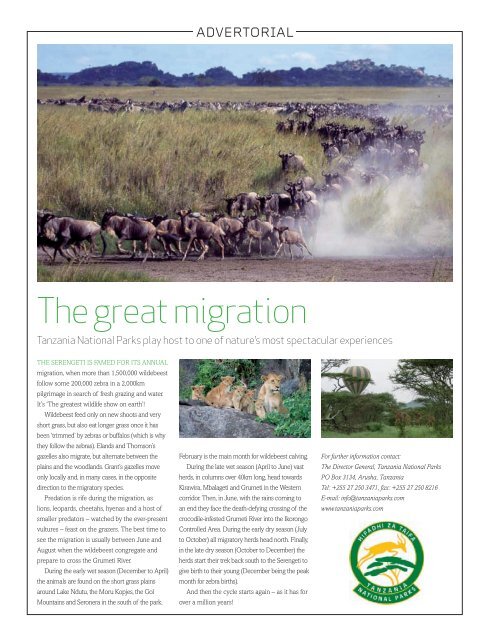february-2012
february-2012
february-2012
You also want an ePaper? Increase the reach of your titles
YUMPU automatically turns print PDFs into web optimized ePapers that Google loves.
ADVERTORIAL<br />
The great migration<br />
Tanzania National Parks play host to one of nature’s most spectacular experiences<br />
THE SERENGETI IS FAMED FOR ITS ANNUAL<br />
migration, when more than 1,500,000 wildebeest<br />
follow some 200,000 zebra in a 2,000km<br />
pilgrimage in search of fresh grazing and water.<br />
It’s ‘The greatest wildlife show on earth’!<br />
Wildebeest feed only on new shoots and very<br />
short grass, but also eat longer grass once it has<br />
been ‘trimmed’ by zebras or buffalos (which is why<br />
they follow the zebras). Elands and Thomson’s<br />
gazelles also migrate, but alternate between the<br />
plains and the woodlands. Grant’s gazelles move<br />
only locally and, in many cases, in the opposite<br />
direction to the migratory species.<br />
Predation is rife during the migration, as<br />
lions, leopards, cheetahs, hyenas and a host of<br />
smaller predators – watched by the ever-present<br />
vultures – feast on the grazers. The best time to<br />
see the migration is usually between June and<br />
August when the wildebeest congregate and<br />
prepare to cross the Grumeti River.<br />
During the early wet season (December to April)<br />
the animals are found on the short grass plains<br />
around Lake Ndutu, the Moru Kopjes, the Gol<br />
Mountains and Seronera in the south of the park.<br />
February is the main month for wildebeest calving.<br />
During the late wet season (April to June) vast<br />
herds, in columns over 40km long, head towards<br />
Kirawira, Mbalageti and Grumeti in the Western<br />
corridor. Then, in June, with the rains coming to<br />
an end they face the death-defying crossing of the<br />
crocodile-infested Grumeti River into the Ikorongo<br />
Controlled Area. During the early dry season (July<br />
to October) all migratory herds head north. Finally,<br />
in the late dry season (October to December) the<br />
herds start their trek back south to the Serengeti to<br />
give birth to their young (December being the peak<br />
month for zebra births).<br />
And then the cycle starts again – as it has for<br />
over a million years!<br />
For further information contact:<br />
The Director General, Tanzania National Parks<br />
PO Box 3134, Arusha, Tanzania<br />
Tel: +255 27 250 3471, fax: +255 27 250 8216<br />
E-mail: info@tanzaniaparks.com<br />
www.tanzaniaparks.com

















